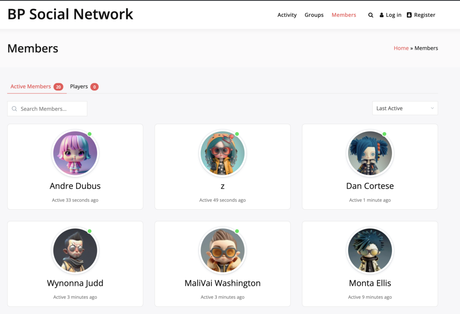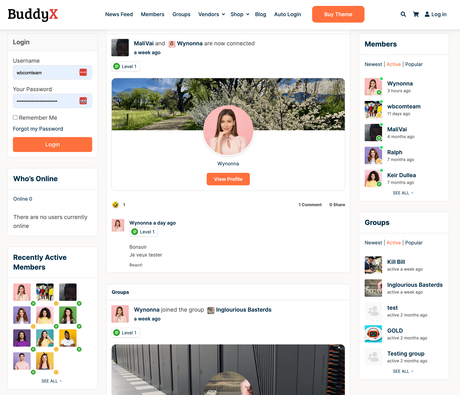In today’s digital age, website accessibility is becoming increasingly important. Websites must be designed and developed to ensure equal access and usability for all users, including those with disabilities. By making websites accessible, we are not only meeting legal requirements but also creating a more inclusive online environment. In this article, we will delve into why website accessibility matters and explore the steps businesses can take to improve their websites.
Create a online Community Website
Checkout BuddyX Theme Demos
Buy BuddyX Pro theme and Community Bundle Addons and create a highly engaging community platform Today!
 Community with BuddyX
Community with BuddyX
A Growing Need for Website Accessibility
The number of people with disabilities is rising, making website accessibility an essential consideration. According to the World Health Organization and the CDC, 16% of the world’s population and 26% of the U.S. population have a disability. This translates to over 1 billion people worldwide and around 86 million people in the U.S. who may face challenges accessing websites that are not designed with accessibility in mind. These disabilities can range from physical and sensory impairments to cognitive and intellectual disabilities.
With such a significant portion of the population affected by disabilities, it is crucial that websites are inclusive and accessible to all. By ensuring that individuals with disabilities can access the same information and services as everyone else, we promote equal opportunities and eliminate barriers that can hinder their participation in various online activities.
Reaching a Wider Audience
Website accessibility not only addresses the needs of individuals with disabilities but also opens up opportunities for businesses to reach a broader audience. By making websites accessible, companies can tap into a large and often overlooked market, potentially leading to increased revenue and growth. In fact, in 2021, e-commerce retailers lost an estimated $828 million during the holiday season due to websites that were not accessible.
Accessible websites also have the potential to enhance a company’s reputation and brand image. When businesses prioritise accessibility, they demonstrate their commitment to inclusivity and customer satisfaction. Additionally, accessible websites can positively impact search engine optimisation (SEO) rankings, further increasing visibility and attracting more visitors.
Legal Compliance and Avoiding Lawsuits
Website accessibility is not only a matter of inclusion and business growth but also a legal requirement. Laws and regulations, such as the Americans with Disabilities Act (ADA), the Rehabilitation Act, and the European Accessibility Act (EAA), exist to protect the rights of individuals with disabilities and ensure equal access to goods and services. Non-compliance with these guidelines can result in legal consequences, including potential lawsuits.
To avoid legal issues, businesses must make website accessibility a priority. It is essential to familiarise oneself with the guidelines outlined by the World Wide Web Consortium (W3C) and the Web Content Accessibility Guidelines (WCAG). These guidelines provide a framework for web developers and designers to follow when creating accessible websites.
Also Read: Performing An Accessibility Audit With An Accessibility Checker
Principles of Website Accessibility
 Consider Website Accessibility
Consider Website Accessibility
The WCAG outlines four main principles of website accessibility that developers and designers should adhere to:
- Perceivable: Users must be able to perceive the information presented on a website. This includes providing alternative text for images, captioning for videos, and ensuring that content is not invisible to any of the user’s senses.
- Operable: Users must be able to operate the interface of a website. This involves making sure that the interface does not require interactions that users cannot perform. Keyboard-only navigation is one example of an operable interface.
- Understandable: Users must be able to understand the information and the operation of the user interface. Clear and simple language should be used, and jargon should be avoided. Providing ways to help users find and understand information is also crucial.
- Robust: Users must be able to access the content as technologies advance. Websites should remain accessible even as technologies and user agents evolve. This means using technologies that are supported by commonly available assistive technologies.
By following these principles, businesses can create websites that are accessible to all users, regardless of their abilities or disabilities.
Steps to Improve Website Accessibility
To ensure that a website is accessible, businesses should consider implementing the following measures. If the list below sounds a little daunting, then consider engaging with website accessibility specialists, such as Hex Productions, who can guide you through the process.
- Incorporate accessibility features: Start by incorporating basic accessibility features such as alternative text for images, captioning for videos, and keyboard-only navigation. These features help individuals with disabilities access and interact with website content.
- Conduct regular testing and evaluations: Regularly test and evaluate your website to identify and address any accessibility barriers. Modifications and updates to a website can sometimes introduce new accessibility issues, so ongoing monitoring is crucial.
- Follow WCAG guidelines: Familiarise yourself with the WCAG guidelines and incorporate them into your website development process. These guidelines provide a comprehensive framework for ensuring website accessibility.
- Provide clear and simple language: Use clear and simple language on your website, avoiding jargon and technical terms that may be difficult for some users to understand. Consider providing additional explanations or definitions for complex concepts.
- Ensure proper navigation: Make sure users can easily navigate through your website using various input methods, including keyboards. Ensure that navigation dropdowns work correctly and that buttons are clearly highlighted.
- Consider assistive technologies: Use technologies that are supported by commonly available assistive technologies. This ensures that users with disabilities can effectively access and interact with your website.
- Conduct accessibility audits: Consider having a professional web accessibility audit done to assess the accessibility of your website. This audit can uncover issues beyond accessibility barriers, such as broken links, responsiveness, and security concerns.
- Train your team: Provide training and awareness sessions to your web development and design teams to ensure they understand the importance of website accessibility and how to implement it effectively.
By taking these steps, businesses can make significant strides in improving the accessibility of their websites and providing equal access to all users.
Conclusion on Consider Website Accessibility
In conclusion, website accessibility is of paramount importance in 2023 and beyond. With a growing number of people with disabilities and legal requirements to comply with, businesses need to prioritise accessibility in their website design and development processes. By making websites accessible, companies can reach a wider audience, comply with legal obligations, and create a more inclusive and user-friendly web experience. Remember, website accessibility is not just about meeting legal requirements but about fostering inclusivity and equal access for all individuals, regardless of their abilities or disabilities.
Interesting Read:
Reign LearnDash Addon
Ensuring Equal Access to Education: The Importance of Accessibility in LMS Platforms
Web Accessibility in Online Learning: A Must-Have Tool

